Windows Recovery Environment (WinRE) is an environment that is used to repair the Windows operating system when an error occurs. After entering WinRE, you can perform different operations on your system, like System Restore, Factory Reset, uninstall Windows updates, Startup Repair, etc. If for some reason, you cannot boot into Windows Recovery Environment, this article will help you. We will show you some fixes that you can use to fix this problem.
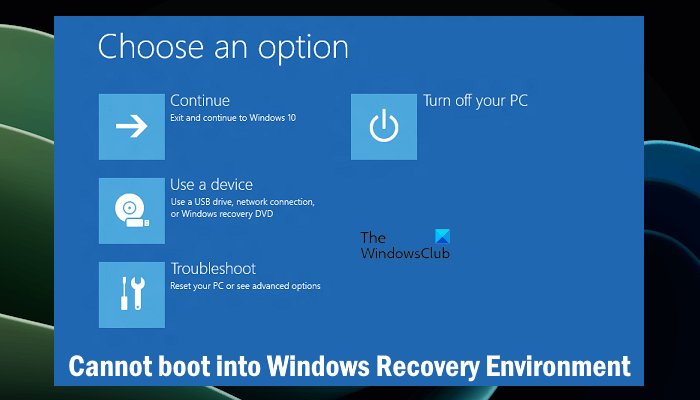
Cannot boot into Windows Recovery Environment
If you cannot boot into Windows Recovery Environment, use the fixes provided below:
- Check the status of the Windows Recovery Environment
- Use other methods to enter the Windows Recovery Environment
- Have you accidentally deleted the Windows Recovery Partition?
- Perform an In-place Upgrade or a Clean installation of Windows
Below, we have explained all these fixes in detail.
1] Check the status of the Windows Recovery Environment
You can enable and disable the Windows Recovery Environment by executing the required command in the elevated Command Prompt or elevated PowerShell window. You won’t be able to boot into the Windows Recovery Environment if it is disabled. Check the status of the Windows Recovery Environment.
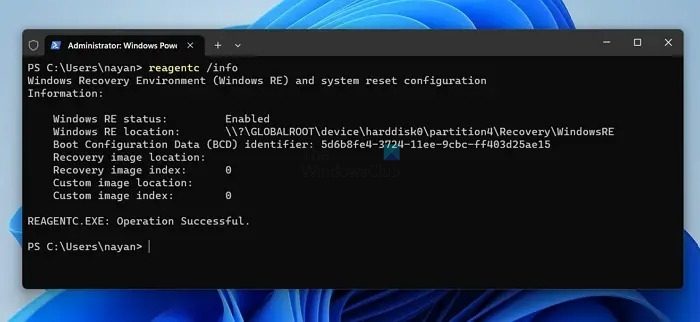
Launch an elevated Command Prompt or elevated PowerShell and type the following command. After that, press Enter.
reagentc /info
The Windows RE Status should show Enabled. If it shows Disabled, run the following command in the elevated Command Prompt and hit Enter.
reagentc /enable
2] Use other methods to enter the Windows Recovery Environment
There are multiple ways to enter the Windows Recovery Environment. Try all of these methods and see if you are successful or not. You can do so by:
- Interrupting the normal boot process
- Using the Shift + Restart
- Using the Settings app
- Using the bootable USB drive
To interrupt the normal boot process, follow the steps provided below:
- Shut down your computer.
- Wait till it shuts down completely. Now, turn on your computer.
- Press and hold the power button immediately when you see the Windows or manufacturer’s logo on the screen. This will force shut down your computer.
Repeat the above steps until you see the Preparing Automatic Repair screen. Now, you are in WinRE.
Alternatively, click on the Start button, then click on the Power icon. Now, press and hold the Shift key and click Restart.
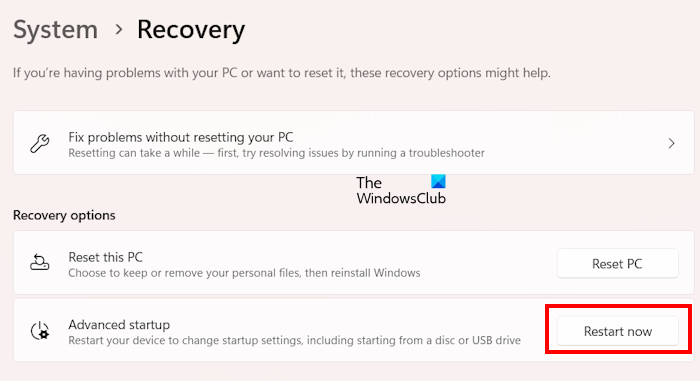
In Windows 11, open Settings and go to System > Recovery. Now, click Restart now under the Advanced startup option.
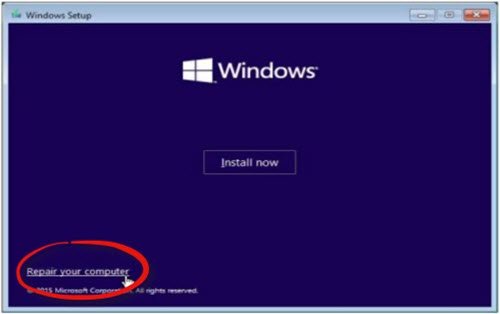
To enter the Windows Recovery Environment from USB, you have to create a bootable USB drive with the Windows 11/10 OS (whichever is applicable in your case). Then, change the boot order to boot from the USB drive. When you boot from USB, click Next and select Repair your computer.
3] Have you accidentally deleted the Windows Recovery Partition?
Windows Recovery Partition is created during Windows installation or when you upgrade your Windows from a lower version to a higher version, say from Windows 10 to Windows 11. If you delete the Recovery Partition on Windows 11/10, you cannot boot into the Recovery Environment. To check this, you can use the built-in tool Disk Management.

Open the Disk Management and see if the Recovery partition is showing there. If not, you might have deleted the Recovery Partition by mistake. You may also find multiple Recovery Partitions on your disk. If the Recovery Partition is not available, you need to perform an In-place Upgrade or Clean installation of Windows.
5] Perform an In-place Upgrade or a Clean installation of Windows
An In-place Upgrade is the process of installing the Windows operating system without removing the currently installed Windows OS. This process does not erase data. We suggest you perform an In-place Upgrade and see if it helps.
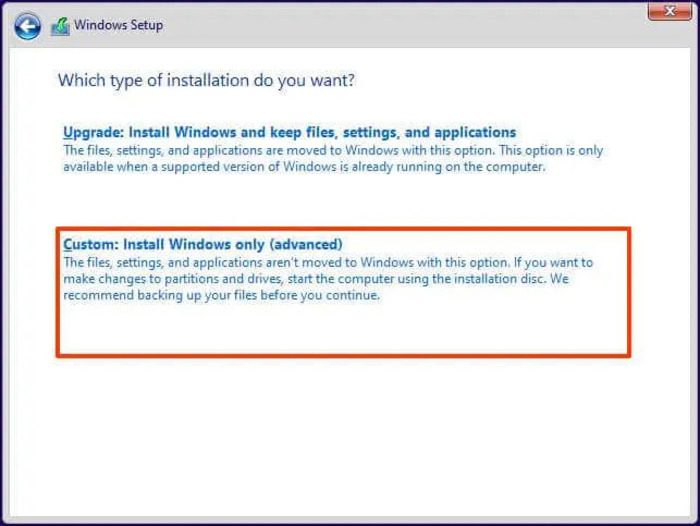
If the problem is not fixed by doing an In-place Upgrade, the last resort is to perform a Clean installation of Windows. This process will delete all the data from your C drive, provided you select the correct drive while formatting the C drive for Clean installation of Windows.
You need to use a bootable USB drive with the Windows OS to perform both the methods mentioned above.
That’s it. I hope this helps.
How do I force Windows Recovery Environment?
There are multiple ways to enter the Windows Recovery Environment. If you are not able to enter WinRE, you can force your system by interrupting the normal boot process. Alternatively, you can also use the bootable USB drive with Windows OS.
How to boot in Safe Mode?
Safe Mode is a troubleshooting mode that loads the Windows operating system with a minimal set of drivers. You can use the MSConfig app to boot into Safe Mode. Alternatively, you can also use the Windows Recovery Environment to boot into the Safe Mode.
Read next: Could not find the Recovery Environment in Windows.